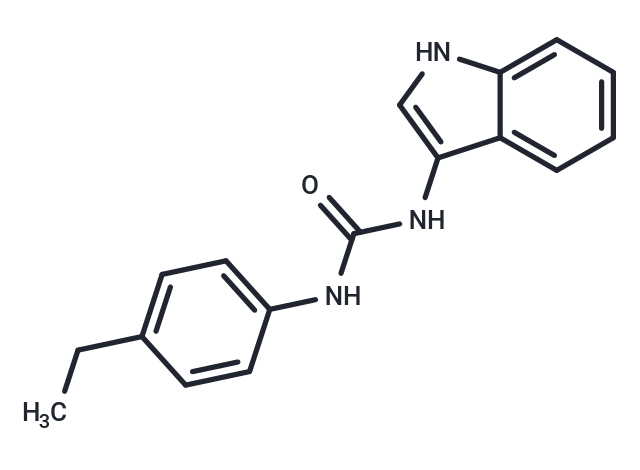Shopping Cart
- Remove All
 Your shopping cart is currently empty
Your shopping cart is currently empty

H-151 is a highly potent and selective STING antagonist. H-151 covalently binds to Cys91 of STING and inhibits palmitoylation of Cys91, thereby inhibiting STING activity. H-151 can be used in the study of autoinflammatory diseases in vivo and ex vivo.

| Pack Size | Price | Availability | Quantity |
|---|---|---|---|
| 2 mg | $30 | In Stock | |
| 5 mg | $47 | In Stock | |
| 10 mg | $72 | In Stock | |
| 25 mg | $148 | In Stock | |
| 50 mg | $296 | In Stock | |
| 100 mg | $452 | In Stock | |
| 500 mg | $987 | In Stock | |
| 1 mL x 10 mM (in DMSO) | $52 | In Stock |
| Description | H-151 is a highly potent and selective STING antagonist. H-151 covalently binds to Cys91 of STING and inhibits palmitoylation of Cys91, thereby inhibiting STING activity. H-151 can be used in the study of autoinflammatory diseases in vivo and ex vivo. |
| In vitro | METHODS: Mouse monocyte macrophage RAW264.7 was treated with H-151 (0.25-2 μM) for 1 h, and then stimulated with rmCIRP (1 μg/mL) for 24 h. The level of IFN-β was measured by ELISA. RESULTS: IFN-β was dose-dependently reduced in the culture supernatant of cells pretreated with H-151, which inhibited eCIRP-induced activation of STING in vitro. [1] METHODS: Human monocytes THP-1 were treated with H-151 (0.5 μM) for 2 h, and the expression levels of target proteins were measured by Western Blot. RESULTS: H-151 inhibited the phosphorylation of TBK1, and H-151 effectively inhibited the activation of hsSTING. [2] |
| In vivo | METHODS: To assay in vivo activity, H-151 (750 nmol, 200 μL) was administered intraperitoneally to Trex1-/- Ifnb1Δβ-luc/Δβ-luc reporter mice once daily for seven days. RESULTS: When administered for one week, H-151 showed significant efficacy in Trex1-/- mice expressing a bioluminescent IFNβ reporter gene. [2] METHODS: To test the role in cisplatin-induced acute kidney injury (AKI), H-151 (7 mg/kg) was administered intraperitoneally to C57BL/6J mice with cisplatin-induced AKI three times a day. RESULTS: H-151 treatment significantly ameliorated cisplatin-induced renal injury, as evidenced by improvement in renal function, renal morphology, and renal inflammation.H-151 may be a potential therapeutic agent for the treatment of AKI, possibly by inhibiting STING-mediated inflammation and mitochondrial damage. [3] |
| Molecular Weight | 279.34 |
| Formula | C17H17N3O |
| Cas No. | 941987-60-6 |
| Smiles | CCc1ccc(NC(=O)Nc2c[nH]c3ccccc23)cc1 |
| Relative Density. | 1.298 g/cm3 (Predicted) |
| Storage | keep away from moisture | Powder: -20°C for 3 years | In solvent: -80°C for 1 year | Shipping with blue ice. | |||||||||||||||||||||||||||||||||||
| Solubility Information | Ethanol: 14.08 mg/ml (50.42 mM), Sonication is recommended. DMSO: 100 mg/mL (357.99 mM), Sonication is recommended. | |||||||||||||||||||||||||||||||||||
| In Vivo Formulation | 10% DMSO+40% PEG300+5% Tween 80+45% Saline: 12.5 mg/mL (44.75 mM), Suspension. Please add the solvents sequentially, clarifying the solution as much as possible before adding the next one. Dissolve by heating and/or sonication if necessary. Working solution is recommended to be prepared and used immediately. The formulation provided above is for reference purposes only. In vivo formulations may vary and should be modified based on specific experimental conditions. | |||||||||||||||||||||||||||||||||||
Solution Preparation Table | ||||||||||||||||||||||||||||||||||||
DMSO
| ||||||||||||||||||||||||||||||||||||

Copyright © 2015-2025 TargetMol Chemicals Inc. All Rights Reserved.